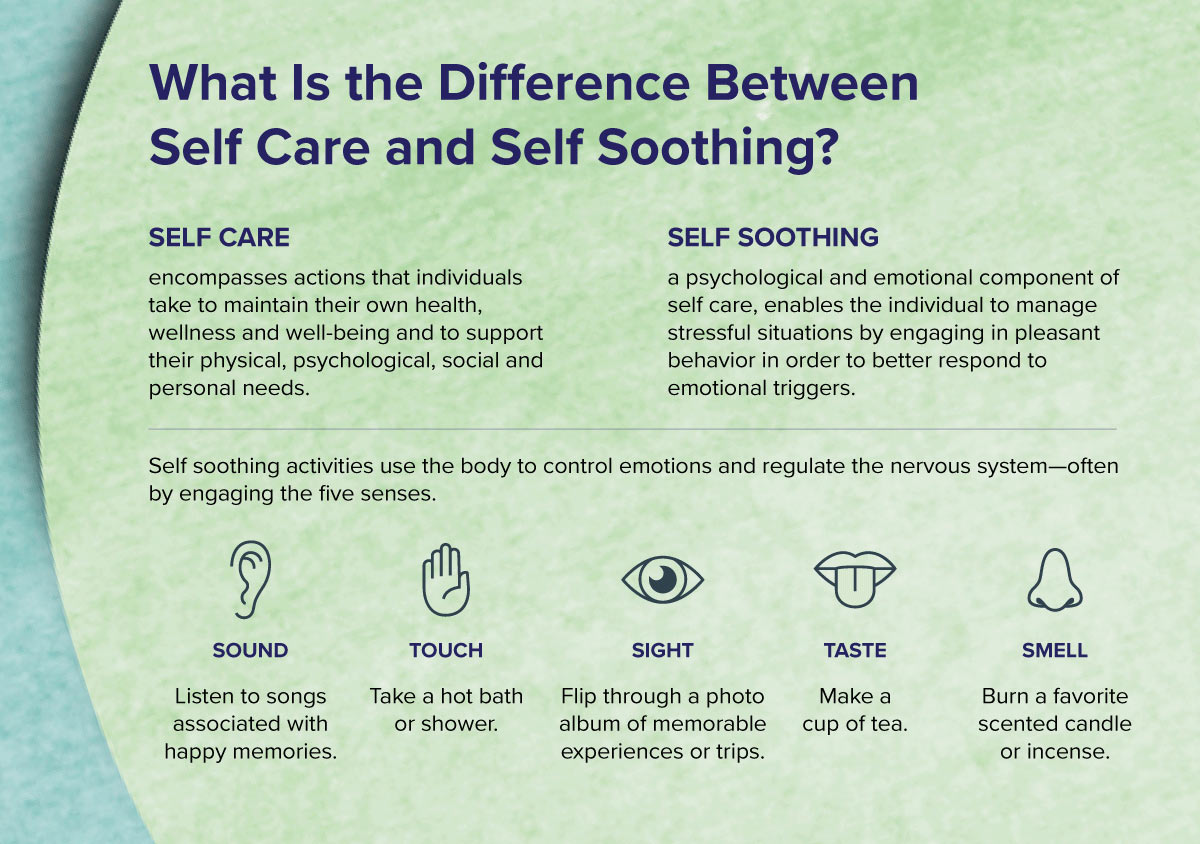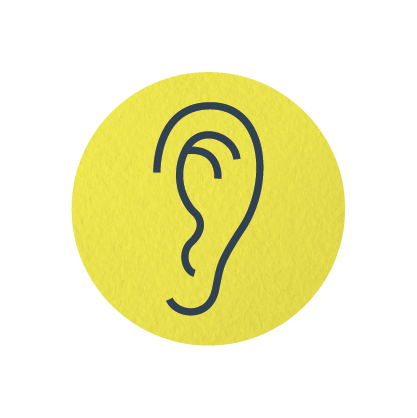Self Soothing Techniques To Include in Your Self Care Routine

When people feel overwhelmed with stress or anxiety, they sometimes turn to a reliable activity to help them calm down. According to Marissa Robinson, a psychotherapist from mytherapyNYC, those activities are a form of self soothing.
“Self soothing helps us survive a million different little things going on in our daily life,” Robinson said. “It’s resisting the urge to do something that would be harmful to yourself and instead soothing yourself in the present moment.”
What Is the Difference Between Self Care and Self Soothing?
There are many different definitions for self care with varying degrees of broadness, but most definitions for the concept refer to the ability of an individual to maintain their own health, wellness and well-being.
For example, the International Self-Care Foundation has created a framework for self care centered around seven pillars, including:
KNOWLEDGE AND HEALTH LITERACY: the ability for individuals to obtain important health information and services in order to make informed decisions about their health.
MENTAL WELL-BEING, SELF AWARENESS AND AGENCY: the ability to manage stressors in daily life and self-assess physical and mental health in order to take appropriate actions.
PHYSICAL ACTIVITY: the practice of engaging in the necessary movement and activity to improve both physical and mental health and prevent disease.
HEALTHY EATING: the practice of consuming a healthy, balanced diet to support physical health and prevent disease.
RISK AVOIDANCE OR MITIGATION: the practice of limiting or eliminating risky behaviors like alcohol use or of proactively protecting oneself when engaging in risky behaviors.
GOOD HYGIENE: the use of practices that promote cleanliness in order to prevent the spread of communicable diseases.
RATIONAL AND RESPONSIBLE USE OF PRODUCTS, SERVICES, DIAGNOSTICS AND MEDICINES: the practice of following directions and using health services and products correctly.
However, even this broad definition does not cover the full range of activities that self care can include. Some definitions incorporate social and professional life, financial choices and community contributions. Overall, self care encompasses the totality of how individuals can best meet their physical, psychological, social and personal needs in daily life.
In contrast, self soothing, which can be a component of self care, is focused on specific moments of distress. A person engaging in self soothing uses a pleasant behavior or activity to help create calm and allow them to move past the situation. Rachel Chang, a psychotherapist at the Manhattan Center for Cognitive-Behavioral Therapy, explained that self soothing can help an individual act less impulsively or prevent them from doing something they may regret.
“The function of self soothing is to help you find more emotional capacity to manage the stress rather than avoiding the problem,” Chang said.
Robinson added that self soothing does not mean that stress disappears, but it does give the individual time and space to respond to emotional triggers. And it can contribute to a person’s overall well-being and sense of self even after stress has passed while strengthening future responses to stress and frustration.

How To Self Soothe Appropriately
When feeling stressed, Robinson suggested using TIPP, which stands for temperature, intense exercise, paced breathing and progressive muscle relaxation. This method of self soothing uses the body to control emotions and regulate the nervous system during anxiety.
T – TEMPERATURE
Wash your face in cold water and hold your breath for about 30 to 60 seconds. You can also use an ice pack and cold washcloth to dab on your face, especially around your cheeks and eyes. Changing your body temperature can be an effective way of lowering the intensity of an emotion.
I – INTENSE EXERCISE
This can help decrease the intensity of emotions and expel your energy. Exercising is a way to release endorphins. Go on a walk or run for about 20 minutes. You can also engage in aerobic exercises. Rate your mood level on a scale of 1–10 before and after you exercise and compare the differences.
P – PACED BREATHING
This activity is about slowing your heart rate and breathing cycle. Breathe deep into your belly and exhale. Repeat this for at least five minutes. There are paced breathing apps that can help you adjust and practice, such as Breathe Easy and Breathe + Simple Breath Trainer.
P – PROGRESSIVE MUSCLE RELAXATION
The goal of this activity is to relax tension in your muscles and improve your emotional state. Tense your muscles and breathe in, and then relax them as you breathe out. Start from your head and move down your body. Say the word “relax” as you do this to create an association with the feeling of relaxation.
Self soothing can also be very simple. Chang encourages doing activities that engage the five senses, which have a nurturing element to them that can create a sense of calm and relaxation.
Simple Self Soothing Activities To Engage Your Five Senses

Sound
- Listen to songs associated with happy memories.
- Find a spot where you can listen to the sounds of nature.
- Repeat positive affirmations to yourself.

Sight
- Flip through a photo album of memorable experiences or trips.
- Take a quick walk just to observe what’s happening outside.
- Watch a clip or episode from your favorite television show.

Smell
- Burn your favorite scented candle or incense.
- Put on a fragrance or apply a scented lotion to yourself.
- Buy a fresh bouquet of flowers for your bedroom.

Touch
- Take a hot bath or shower.
- Play with a pet.
- Reorganize or declutter an area of your living space.

Taste
- Make yourself a cup of tea.
- Order a meal or a treat from your favorite restaurant.
- Make your favorite home-cooked meal.
Although these activities can be beneficial to help a stressful moment pass, it’s important not to dwell too much in self soothing to the point that it becomes unhealthy, Robinson said. The goal is not to avoid the problem but to dedicate that time and space to soothe yourself so you can address what’s going on more effectively.
“Just because we self-soothe with the TV show or a bubble bath doesn’t mean that the emotions aren’t there anymore. It just means we were distracted from it for a bit,” Robinson said. “When you take time to allow yourself to really feel and experience the emotion, it helps you come back to yourself.”
It’s also important to remember that part of self soothing is building muscle memory with a reliable activity that an individual can return to in time of need. The moment in crisis is not the ideal time to try a new activity to see if it works.
“We’re not running a marathon without any practice. We’re practicing for that big moment, for that challenge and crisis mode,” Robinson said.
Encouraging Loved Ones To Engage in Self Care
Both self care and self soothing can work together to help individuals stabilize emotions and confront emotional crises in healthy ways. And while it can be beneficial to understand how to self soothe, it can also be important not to forget the bigger picture of self care.
“Self care is one of those things where you use your vulnerability so that you have more gas in your tank to manage stress,” Chang said. “You have to keep doing it to make yourself feel better. Just because you do it once a week…doesn’t make you feel better right away. It’s about consistency.”
While self-directed exercises at home may be helpful for some, others may need more guidance. For friends and family who see someone in their lives struggling, stepping in to encourage self care, which can include seeking help from a mental health professional, may be just what they need. Chang and Robinson offered tips on how to engage in these conversations.
How Do We Encourage Self Care for Others?
BE AWARE OF HOW THEY TAKE CARE OF THEMSELVES. Look for cues that might signal distress. Are they on the move a lot, always on the go and failing to pay attention to their mental, physical, financial and emotional health?
PICK AN APPROPRIATE TIME TO DISCUSS SELF CARE. Be intentional about when and where you talk to them. Avoid texting during a busy work day, and make sure they feel comfortable and safe and that they are in a good emotional state when you open dialogue.
USE “I” STATEMENTS. Avoid blame. Instead of saying, “Why do you burn yourself out?”, say, “I notice you’re on the move a lot, and I want to make sure you’re not burning yourself out.” Create a compassionate space that doesn’t feel like a personal attack.
VALIDATE HOW THEY ARE FEELING. Validation helps people feel heard. Offer to engage in self soothing activities together. Schedule activities for when there is not an emotional crisis in order to prepare for when one does occur.
Information on OnlineMSWPrograms.com is not intended to be a substitute for professional mental health advice. Always consult qualified professionals with any questions you may have about mental and behavioral health-related issues.
This article was published February 2022.

